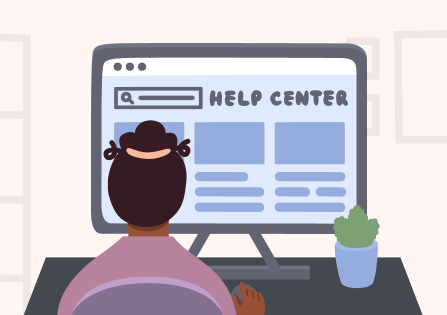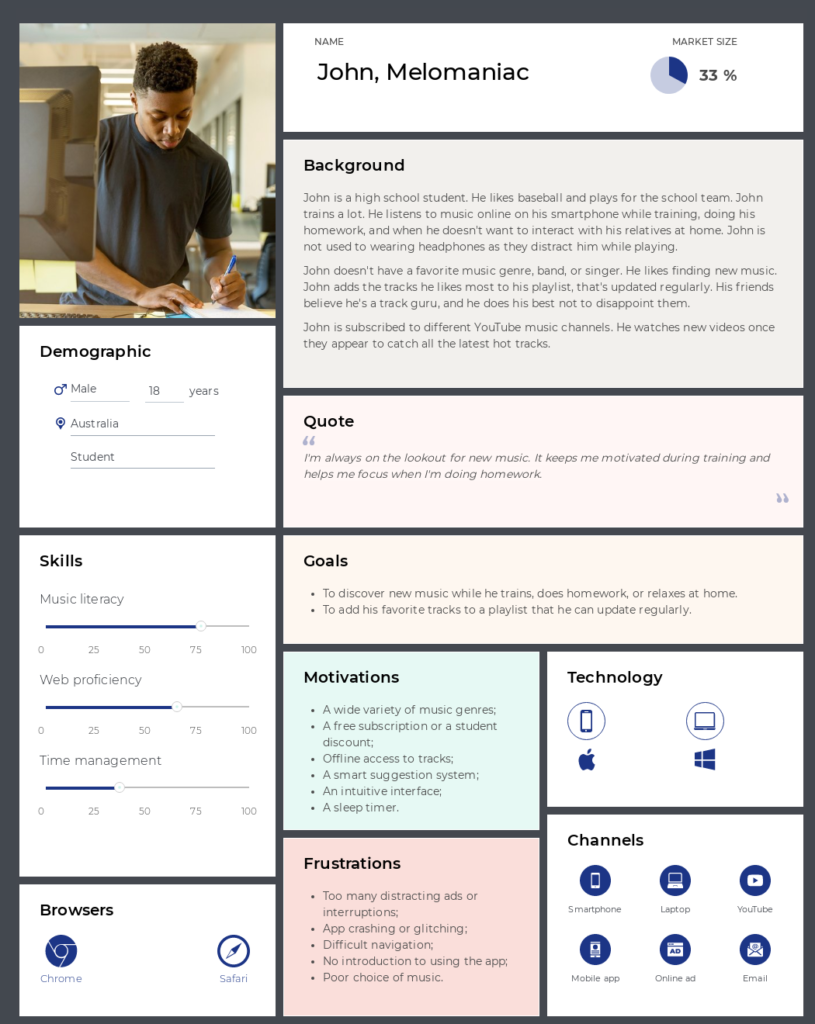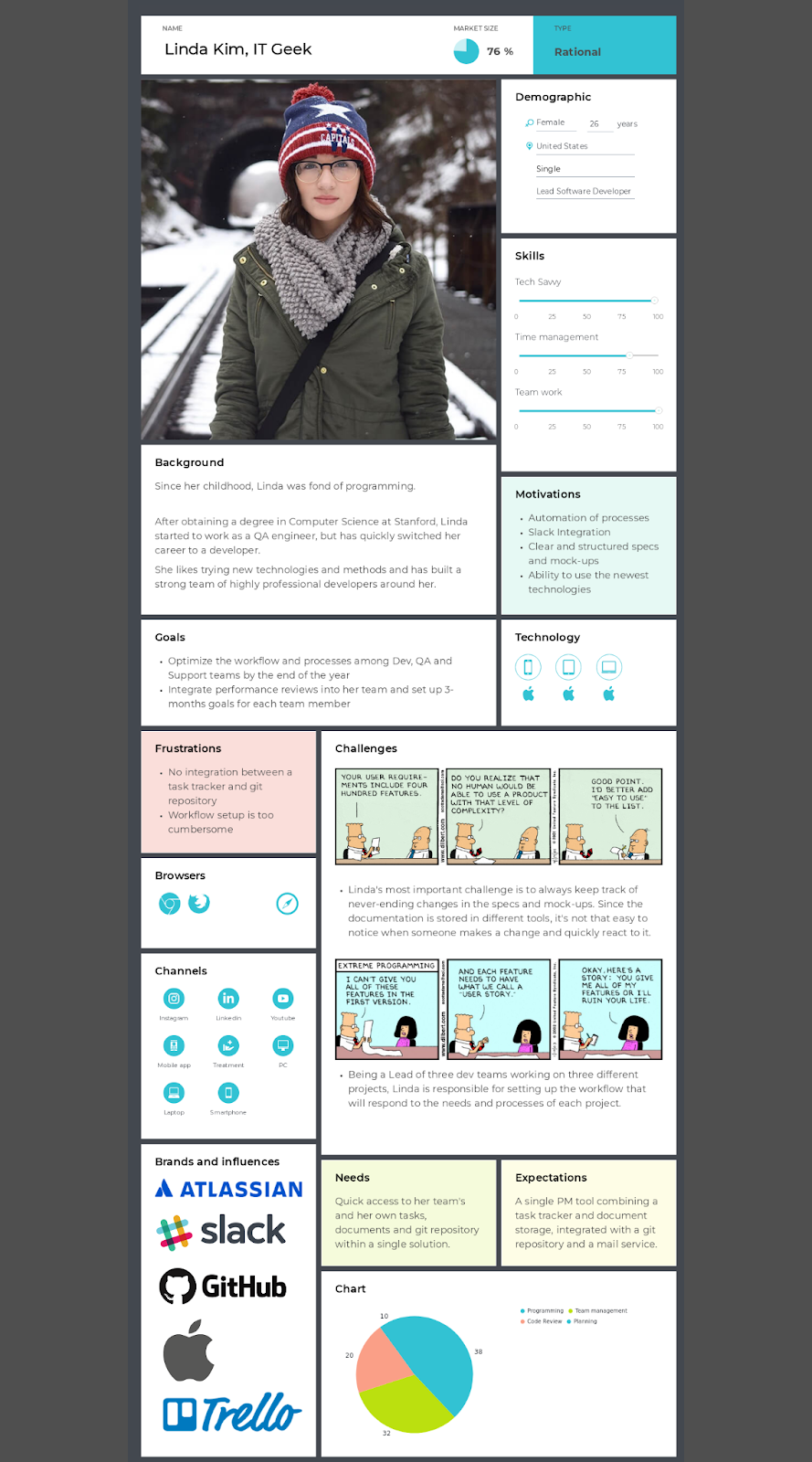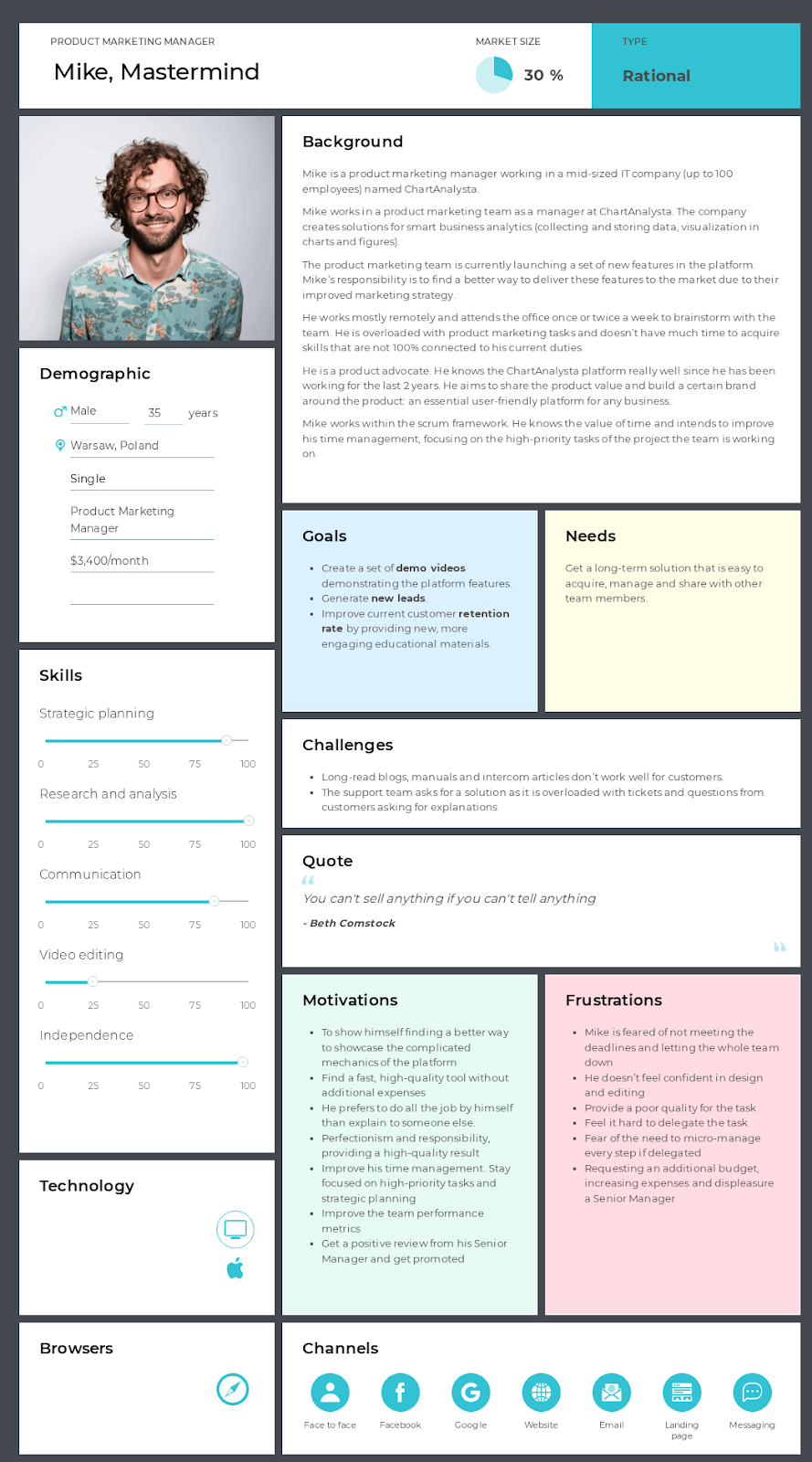Making a great product is like cooking a special meal. You need to know who you're making it for. Think of yourself as a cook mixing different tastes for your guests. This is like making a user persona — combining art and understanding of your audience to make a human-like description of your user segment.
This guide is like your recipe book for user personas. We made it simple, showing you the process step by step. It's not just about mixing different characteristics of people who use your products or services; it's about creating a story that connects with them.
Join us in our “kitchen” as we show you how to pick the right data, understand your audience's likes, and make a persona that really shows who your customers are. With this method, you can make choices that truly touch your audience, adding care and relevance to your product or service.
Contents
What is a user persona?

A user persona is important as it serves as a detailed representation of your target audience. It's a tool used in marketing, product design, and user experience design to help creators and businesses understand their customers better.
A user persona profile is based on market research and real data about existing customers, and it typically includes details like
- Demographics (age, gender, income level, education, occupation, etc.);
- Behavior (interests, hobbies, spending habits, social media usage, etc.);
- Needs and goals (what they want to achieve, their motivations, their challenges, and pain points.);
- Psychographics (personality traits, values, attitudes, lifestyle).
The purpose of a user persona is to help businesses empathize with their users and make decisions that cater to their needs and preferences. By visualizing their audience as real people with specific characteristics and needs, companies can design products, services, and marketing strategies that are more likely to resonate with their target market.
How to create a user persona?

Creating a user persona involves several phases aimed at gathering and synthesizing information about your target audience into a relatable, fictional character. We’ll split those into three broad steps.
Step 1. Do research
Researching your audience to create a user persona is a crucial step that includes gathering and analyzing data to understand your target users' characteristics, needs, and behaviors.
- Define your research objectives. Clearly define what you want to learn about your current and potential customers. This might include their demographics, behaviors, preferences, pain points, skills, goals, you name it.
- Conduct user interviews. Reach out to customers for one-on-one interviews. Prepare open-ended questions that explore their lifestyle, challenges, goals, and how they interact with products or services similar to yours.
- Utilize surveys and questionnaires. Design surveys and distribute those widely to gather broader demographic and behavioral data. Use online tools like Google Forms or SurveyMonkey to reach a larger audience. Include both open-ended questions and multiple-choice questions to gather diverse data.
- Analyze existing customer data. If you have an existing customer base, dive into your analytics. Look at purchase history, customer service interactions, and any available demographic data. Tools like Google Analytics can provide insights into how users interact with your website or product.
- Explore social media and online communities. Monitor social media platforms and online forums where your potential customers might spend their time. Look for discussions about needs, preferences, and frustrations related to your industry. Social listening tools can also help in analyzing these conversations on a larger scale.
- Study market trends and industry reports. Stay informed about your industry's trends and consumer behavior reports. These can offer valuable insights into broader market shifts that might affect your audience's preferences and needs. You can also leverage AI technologies to collect and analyze the needed data.
- Create empathy maps. Use empathy maps to document what your users think, feel, see, and do. This can help in better understanding their emotional and motivational landscape.
The goal of this research is to create a realistic representation of your key user segments.
Step 2. Compile, analyze, and do a draft
After conducting user research, the next crucial step in creating a user persona is identifying patterns and segments within the collected data. This involves analyzing and organizing the information to find common characteristics and behaviors among your potential users. Actually, there are many segmentation methods, but we recommend behavioral segmentation because it helps us understand not just what your audience does (that's already visible) but why they do it.
Here's how to do it in detail, with examples:
- Organize and review your data. Gather all the data you've collected from interviews, surveys, social media, and other sources.
- Look for common characteristics. Analyze the data to identify shared characteristics among your users. You might notice that many users are in their 30s, work in creative professions, and express a strong interest in eco-friendly products.
- Identify needs and goals. Determine common goals, needs, and challenges that emerge from your data. What are the primary problems your users want to solve? A common need might be finding time-saving solutions for daily tasks, as expressed by several interviewees.
- Segment your audience. Based on these commonalities, divide your audience into distinct segments. Each segment should represent a group with similar characteristics and needs. One segment could be 'Eco-conscious Creatives,' consisting of young professionals interested in sustainability and creative hobbies.
- Validate your segments. Cross-reference your segments and hypotheses with your data to ensure they are accurate reflections of your audience.
- Prioritize segments. Determine which segments are most relevant to your product or service. Not all segments will have the same importance for your business goals.
- Refine and iterate. Be prepared to refine your segments as you gather more data or as market conditions change.
After you've completed these steps, you'll have a few audience segments that can be drafts of your future persona profiles. The next important step is to effectively visualize them. This is step number three.
Step 3: Visualize your user persona
You can visualize your personas in many ways, ranging from sketches in a notebook or on a whiteboard to creating digital versions using professional tools like UXPressia. The end result of your efforts will approximately look like this:

Questions to ask during persona creation

When creating a user persona, asking the right questions is crucial for gathering comprehensive and relevant information. These questions can be categorized based on different aspects of the persona you want to develop. Here's a list of key questions to consider:
Demographic questions
When developing a comprehensive understanding of a user persona, it is essential to explore various demographic aspects. These details not only paint a clearer picture of the individual but also provide valuable insights into their behaviors, preferences, and needs. Here are some key demographic questions to consider:
- What is their age range?
Why: Helps determine the life stage, priorities, and potential technological proficiency of the persona.
- What is their gender?
Why: Influences preferences and needs and may impact how users interact with products or services.
- What is their marital status?
Why: Affects lifestyle choices, purchasing decisions, and responsibilities.
- What is their educational background?
Why: Offers insight into their knowledge level, interests, and possibly socioeconomic status.
- Where do they live?
Why: Cultural, geographical, and economic factors tied to location can impact consumer behavior. For example, web applications may not be available in all countries where you'd like to have a presence. And you’d want to consider it.
- What is their occupation and income level?
Why: Determines purchasing power, lifestyle, and possibly the challenges they face in their professional life.
Psychographic questions
To deeply understand a user persona, it's crucial to delve into their psychographics. This exploration goes beyond mere demographics to unearth the psychological and social factors that influence their behavior and preferences. Here are some pertinent psychographic questions to consider:
- What are their personal values and beliefs?
Why: Drives decision-making, brand loyalty, and product preferences.
- What are their interests and hobbies?
Why: Helps tailor marketing messages and aligning product features with user preferences.
- What lifestyle do they lead?
Why: Influences the type of products they need and the marketing channels to reach them.
- What are their personality traits?
Why: Affects how they interact with your product and respond to different types of messaging.
- What motivates them in their personal and professional life?
Why: Understanding what drives them helps in creating products and messages that resonate.
- What are their fears and aspirations?
Why: Helps in understanding their pain points and how your product can solve their problems or fulfill their aspirations.
Behavioral questions
Behavioral questions are crucial for understanding how a user interacts with their environment, including products and services. This understanding can significantly influence product design, marketing strategies, and customer engagement. Here are some essential behavioral questions to start with:
- How do they typically spend their day?
Why: Provides context for when and how they might use your product.
- What brands or products do they currently use, and why?
Why: Offers insight into their preferences and dissatisfaction with current solutions.
- How do they prefer to shop (online, in-store, etc.)?
Why: Influences the design of the purchasing process and distribution channels.
- What social media platforms do they use regularly?
Why: Guides on where to focus digital marketing efforts.
- What are their media consumption habits (types of shows, publications, websites)?
Why: Helps in deciding on advertising channels and content style.
- How do they make decisions about purchasing a product or service?
Why: Understanding how they make purchase decisions is key to optimizing sales strategies.
Needs and goals
Understanding the needs and goals of your target persona is pivotal in developing products and services that effectively meet their requirements and aspirations. This insight drives the alignment of your offerings with their expectations and desires. Here are some questions to explore in this context:
- What are their main goals and objectives?
Why: Aligns product development to meet their specific goals.
- What challenges and pain points do they face regularly?
Why: Identifies opportunities for your product to solve their problems.
- What does success look like to them in their personal and professional life?
Why: Guides the creation of value propositions that resonate with their aspirations.
- What are they trying to achieve by using your product or service?
Why: Ensures that the product features match their requirements.
- What features or benefits are most important to them?
Why: Directs product development and marketing focus.
Product-specific questions
Focusing on product-specific questions allows you to tailor your offerings more precisely to the needs and preferences of your target audience. It helps in refining the product's features, marketing strategy, and overall user experience. Here are some product-specific questions to ask:
- How would they use your product or service?
Why: Helps in refining the product to better suit their needs.
- What features of your product or service are most appealing to them?
Why: Indicates which aspects to highlight in marketing and further develop.
- Are there any barriers or hesitations they might have regarding your product?
Why: Identifies potential objections to address in marketing and product design.
- What would make them choose your product over competitors?
Why: Offers insights into positioning against competitors.
- What feedback or improvements do they suggest for your product or service?
Why: Essential for continuous product improvement and customer satisfaction.
Additional considerations
When developing a comprehensive understanding of a user persona, it's also essential to consider external factors and communication preferences. These insights can greatly enhance the effectiveness of your engagement strategies and customer service. Here are a few additional considerations to explore:
- What external factors (like economic or social trends) might influence their behavior?
Why: Acknowledges factors beyond your control that might affect their behavior or needs.
- How do they prefer to be communicated with (email, social media, phone calls)?
Why: Guides how to effectively engage with them.
- What kind of support or customer service do they expect?
Why: Customer Service Expectations: Important for designing support systems and services.
User persona examples
To assist you in finding inspiration or figuring out how to organize the information into a user persona, consider exploring persona templates from the UXPressia library. There, you'll find a wealth of examples, including both personas and journey maps.
Both persona profiles can form the basis of yours if you want to analyze the users of your tool. Download them for free and enjoy:
Wrapping up
In crafting a user persona, we've journeyed through the intricacies of understanding and empathizing with our target audience. From the initial research, akin to selecting the finest ingredients, to the careful analysis, much like the meticulous preparation of a gourmet dish, every step is pivotal.
We've learned that creating a user persona isn't merely aggregating data; it's about weaving a narrative that connects on a human level. It's about seeing numbers and trends as real people with stories, ambitions, and challenges. This persona becomes a beacon, guiding product development, marketing strategies, and customer interactions, ensuring they are not just efficient but also heartfelt and genuine.
The beauty of this process lies in its adaptability and relevance across various industries. Whether you're developing a cutting-edge tech tool or a new line of eco-friendly products, understanding your user is paramount. It's about striking a chord with your audience, where your product or service doesn't just meet a need but resonates with their lifestyle, values, and aspirations.
As we wrap up, remember that a user persona is more than a tool. It's a commitment to stay attuned to their needs, desires, and experiences, ensuring that every product decision, every marketing message, and every customer interaction is not just informed but inspired by the real people who make up your market.
This dedication to understanding and empathy isn't just good business practice; it's the foundation of a brand that connects deeply and meaningfully with its audience. As you step forward in creating your user personas, embrace this opportunity to understand your audience and become a part of their story, delivering solutions as unique and dynamic as they are.
Ready to build your user persona?








